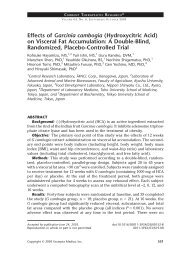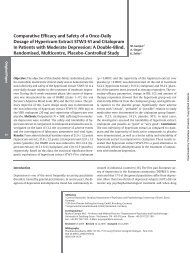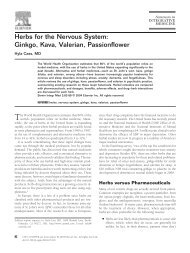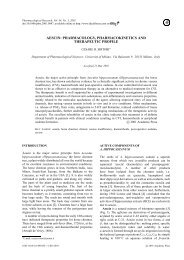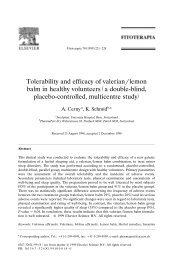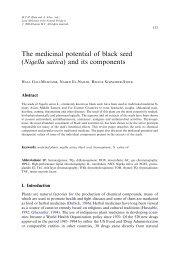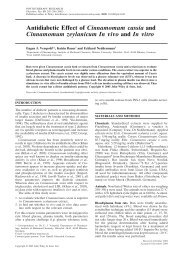Harpagophytum procumbens - Nutraxin
Harpagophytum procumbens - Nutraxin
Harpagophytum procumbens - Nutraxin
Create successful ePaper yourself
Turn your PDF publications into a flip-book with our unique Google optimized e-Paper software.
Journal of Ethnopharmacology 91 (2004) 325–330<br />
Evaluation of acute and chronic treatments with <strong>Harpagophytum</strong><br />
<strong>procumbens</strong> on Freund’s adjuvant-induced arthritis in rats<br />
Monica L. Andersen ∗ , Eduardo H.R. Santos, Maria de Lourdes V. Seabra,<br />
Ana A.B. da Silva, Sergio Tufik<br />
Department of Psychobiology, Universidade Federal de São Paulo, Rua Napoleão de Barros, 925, Vila Clementino, SP-04024-002 São Paulo, Brazil<br />
Received 17 May 2002; received in revised form 22 December 2003; accepted 8 January 2004<br />
Abstract<br />
The extract of <strong>Harpagophytum</strong> <strong>procumbens</strong>, widely utilized in Europe and, more recently, in other countries, is traditionally indicated to<br />
treat inflammatory processes. <strong>Harpagophytum</strong> <strong>procumbens</strong> acts by way of interleukins and leukocyte migration to the painful and inflamed<br />
joint area. Chemically, its secondary tuberous roots contains iridoid glycosides, harpagogide, procumbide, and harpagoside, as the active<br />
principle. The purpose of the present study was evaluate the therapeutic potential as anti-inflammatory and analgesic agent in rat model of<br />
Freund’s adjuvant-induced arthritis both in the acute and chronic phases. The animals were injected with Freund’s adjuvant in sub-plantar<br />
tissue of the right posterior paw and randomly assigned in acute (25, 50, or 100 mg/kg) or chronic (100 mg/kg) treatments with <strong>Harpagophytum</strong><br />
<strong>procumbens</strong> solution test or vehicle. Then, submitted to behavioral test and assessment of body weight and right paw’s measurements. The<br />
results show that <strong>Harpagophytum</strong> <strong>procumbens</strong> extract increased the animals ‘latency of paws’ withdrawal, indicating a protective effect<br />
against the pain induced by the thermal stimulus, both in acute and chronic treatments. In addition to reduction in the right paw edema in<br />
the experimental groups when compared to control group. Thus, the data showed anti-inflammatory and peripheral analgesic properties of<br />
<strong>Harpagophytum</strong> <strong>procumbens</strong> extract with all doses tested, thus confirming its indication for inflammatory processes.<br />
© 2004 Elsevier Ireland Ltd. All rights reserved.<br />
Keywords: <strong>Harpagophytum</strong> <strong>procumbens</strong>; Freund’s adjuvant-induced arthritis; Anti-inflammatory properties; Antinociceptive effects; Rats<br />
1. Introduction<br />
Popularly known as “devil’s claws,” <strong>Harpagophytum</strong><br />
<strong>procumbens</strong> D.C. (de Candolle; Volk, 1953) is a plant, originated<br />
from Southern Africa, specifically, from the Kalahari<br />
Desert and Namibia steppes. The plant counting to family<br />
of Pedaliaceae has been widely utilized for anti-rheumatic<br />
treatment in European countries and has recently been introduced<br />
in Brazil. <strong>Harpagophytum</strong> <strong>procumbens</strong> acts by way<br />
of interleukins and leukocyte migration to the painful and<br />
inflamed joint area (Copelman, 1996). It does not interfere<br />
with the prostaglandins’ cascade, favoring the indication<br />
of this plant in ostheoarthritis, arthroses and arthritis processes,<br />
as well as in arthralgias of inflammatory etiology<br />
and myalgias (Copelman, 1996). Chemically, its secondary<br />
tuberous roots contains iridoid glycosides, mainly harpagoside,<br />
harpagogide and procumbide (Van Haelen, 1986).<br />
∗ Corresponding author. Tel.: +55-11-5539-0155;<br />
fax: +55-11-5572-5092.<br />
E-mail address: mandersen@sti.com.br (M.L. Andersen).<br />
0378-8741/$ – see front matter © 2004 Elsevier Ireland Ltd. All rights reserved.<br />
doi:10.1016/j.jep.2004.01.003<br />
Several clinical and animal studies have demonstrated the<br />
efficacy of <strong>Harpagophytum</strong> <strong>procumbens</strong> in rheumatic diseases,<br />
in addition to its analgesic properties (Lanhers et al.,<br />
1991). In regard to its anti-inflammatory effects, Van Haelen<br />
(1986) reported that <strong>Harpagophytum</strong> <strong>procumbens</strong> presents<br />
efficient results in sub-acute processes. Other studies, however,<br />
have not confirmed these findings (McLeod et al., 1979;<br />
Grahame and Robinson, 1981; Whitehouse et al., 1983).<br />
Freund’s adjuvant-induced arthritis have been used as<br />
a model of sub-chronic or chronic inflammation in rats<br />
and is of considerable relevance for the study of pathophysiological<br />
and pharmacological control of inflammatory<br />
processes, as well as the evaluation of analgesic potential<br />
or anti-inflammatory effects of drugs (Butler et al., 1992;<br />
Besson and Guilbaud, 1988). One of the reasons for the<br />
wide utilization of this model is due to the strong correlation<br />
between the efficiency of therapeutic agents in this<br />
model and in rheumatoid arthritis in humans. The arthritis is<br />
induced by a sub-cutaneous injection of Freund’s adjuvant.<br />
The denatured Mycobacterium butyricum suspended in mineral<br />
oil can be injected sub-cutaneously at the base of the<br />
rat’s tail or in the paw’s plantar surface, or by intra-joint via.
326 M.L. Andersen et al. / Journal of Ethnopharmacology 91 (2004) 325–330<br />
The adjuvant elicits arthritis predominantly in the joints of<br />
hind limbs, promoting significant reduction of motor activity<br />
and increased itching and scratching behaviors (Calvino<br />
et al., 1987). In addition, increased sensitivity of the affected<br />
paw to pressure or flexion and extension of the inflamed<br />
joints and weight loss are observed (Besson and Guilbaud,<br />
1988). The arthritis observed in rats is associated with a<br />
hyperalgesia phenomenon (Calvino et al., 1987) and spontaneous<br />
behaviors, such as protection of the affected paw,<br />
evidenced by curving and/or elevation of the paw, as well as<br />
avoidance of supporting the body on the paw (Clatworthy<br />
et al., 1995). The hyperalgesia is more evident during the<br />
acute inflammatory phase, when spontaneous behaviors, indicative<br />
of painful response are more pronounced (Calvino<br />
et al., 1987). Increased paws’ diameter (posterior and anterior),<br />
due to inflammation and edema is also observed (Cain<br />
et al., 1997). The initial inflammatory response is developed<br />
within hours, but more critical clinical signals emerge from<br />
the 10th post-inoculation day and thereafter, and the alterations<br />
remain detectable for several weeks (Colpaert et al.,<br />
1982). According to Abbadie and Besson (1994), maximum<br />
arthritic response is obtained in 3 weeks.<br />
Considering the anti-inflammatory effects of <strong>Harpagophytum</strong><br />
<strong>procumbens</strong> have only been described on sub-acute<br />
and on acute processes, and the controversial data related to<br />
these anti-inflammatory and analgesic effects, the purposes<br />
of the present study were:<br />
(a) to examine the anti-inflammatory effects of <strong>Harpagophytum</strong><br />
<strong>procumbens</strong> in rats submitted to the model of<br />
Freund’s adjuvant-induced arthritis;<br />
(b) to evaluate its possible analgesic effects;<br />
(c) to differentiate between acute and chronic treatments.<br />
2. Methodology<br />
2.1. Animals<br />
Ninety-day-old Wistar male rats, bred, and raised in the<br />
Animal Facility of the Department of Psychobiology of Universidade<br />
Federal de São Paulo were used in this study.<br />
They were maintained under constant automatically control<br />
12 h/12 h light/dark cycle (lights on from 07.00 a.m. to<br />
07.00 p.m.) and environmental temperature (23 ± 1 ◦ C). Rat<br />
chow and tap water were provided ad libitum in standard<br />
propylene cages. Cage cleaning consisted of daily change<br />
of sawdust bedding. At the end of the study, animals were<br />
sacrificed with an overdose of chloral hydrate.<br />
2.2. Number of animals<br />
Due to the painful condition imposed on the animals,<br />
the number of subjects used was restricted to the minimum<br />
that allowed reliable statistical analysis of the results. All<br />
procedures were submitted to and approved by the Ethics<br />
Fig. 1. Chemical structure of harpagoside, the main component of<br />
<strong>Harpagophytum</strong> <strong>procumbens</strong>.<br />
Committee of Universidade Federal de São Paulo (process<br />
#063/99) and followed the recommendations of the Research<br />
and Ethics Committee of IASP (1983). Each group was composed<br />
of 10 animals.<br />
2.3. Plant material<br />
<strong>Harpagophytum</strong> <strong>procumbens</strong> D.C. roots were obtained<br />
from Börner GmbH (Berlin, Germany) as a dry extract and<br />
under the care of Zenimport Ltd. (Rio de Janeiro, Brazil). A<br />
voucher specimen (<strong>Harpagophytum</strong> <strong>procumbens</strong> ASC 2102)<br />
is kept in the National Herbarium of Namibia, National<br />
Botanical Research Institute, Namibia, and Africa. The active<br />
principle as harpagoside as shown in Fig. 1.<br />
2.4. Extraction procedure<br />
Plant materials were extracted with 60% ethanol and<br />
stirred mechanically. The ethanol was evaporated and the<br />
volume brought to the desired concentration before use.<br />
The native extract (harpagoside) proportion is 80–90%<br />
and the weight ratio “extract/drug” of <strong>Harpagophytum</strong><br />
<strong>procumbens</strong> and rad. sicc. is 4:1/60%. The yield was<br />
10% in average, based on the presence of solid residues.<br />
The analytical method used was the High Performance<br />
Liquid Chromatography (HPLC) with Diode Array detector.<br />
The quality of the plant extract is guaranteed in the<br />
framework of the assay in the final product by the HPLC<br />
method by comparing the retention times and the content of<br />
harpagoside in the HPLC-chromatogram with the standard<br />
substance and the content in the controlled and released<br />
material (extract). The evidence of harpagoside in the extract<br />
is done according to the European Pharmacopoeia<br />
(1997), monograph for Harpagophyti radix. The purity tests<br />
showed content of harpagoside 1.5%. (Note: According<br />
to the monograph published in European Pharmacopoeia<br />
(1997), the requirement is that “it contains not less than<br />
1.2% of harpagoside, calculated with reference to the dried<br />
drug.”)<br />
2.5. Pharmacological experiments<br />
All experiments were conducted in a quiet room between<br />
09.00 and 11.00 a.m. at constant temperature of 23 ± 1 ◦ C.<br />
All solutions were daily prepared in distilled water and<br />
stirred until the residues were completely dissolved. The
volume injected was 1 ml/kg of body weight. Control animals<br />
received the same volume of distilled water.<br />
2.6. Induction of arthritis<br />
Following anesthesia (140 mg/kg of ketamina chloride<br />
i.p.), 0.1 ml of Freund’s adjuvant (complete fraction of Mycobacterium<br />
butyricum suspended in mineral oil; Sigma<br />
Chemical Co., USA) was injected in the sub-plantar tissue of<br />
the right posterior paw. One hundred percent of the animals<br />
developed arthritis. Everyday animals were carefully and<br />
thoroughly inspected, by examining the affected paw and the<br />
animal’s general status. Evaluation of the anti-inflammatory<br />
effects of <strong>Harpagophytum</strong> <strong>procumbens</strong> was performed by<br />
monitoring the edema in the right paw. In control animals,<br />
sub-plantar injection of Freund’s adjuvant produced a pronounced<br />
local edema after a few hours with a progressive<br />
increase reaching its maximum in the eighth day after inoculation<br />
(Experiment 1) or reaching an average of 12 mm in<br />
the 40th day after induction of the arthritis (Experiment 2).<br />
2.7. Acute treatment with <strong>Harpagophytum</strong> <strong>procumbens</strong><br />
On Day 0, all animals were subjected to behavioral tests,<br />
assessment of body weight and measurements of the right<br />
paw (Test 1). Subsequently, Freund’s adjuvant was injected<br />
in the right paw. Five days after administration of Freund’s<br />
adjuvant, animals were again subjected to the tests (Test 2)<br />
and were randomly assigned to one of four groups: control<br />
(CTRL), which received distilled water (1 ml/kg); experimental<br />
Group 1, 25 mg/kg (H-25); Group 2, 50 mg/kg<br />
(H-50); and Group 3, 100 mg/kg (H-100) of <strong>Harpagophytum</strong><br />
<strong>procumbens</strong> preparation, followed by the tests. On Days<br />
6, 7, and 8 administration of the test solution were repeated<br />
(Tests 3, 4, and 5, respectively).<br />
2.8. Chronic treatment with <strong>Harpagophytum</strong> <strong>procumbens</strong><br />
On Day 0, all animals were subjected to behavioral test<br />
and assessment of body weight and right paw’s measurements,<br />
followed by the injection of Freund’s adjuvant in the<br />
right paw (Test 1). On the 10th day after adjuvant administration,<br />
all tests were repeated (Test 2). On the 20th day,<br />
animals were randomly distributed into two groups: control,<br />
treated with distilled water (1 ml/kg of body weight), and experimental<br />
(100 mg/kg of <strong>Harpagophytum</strong> <strong>procumbens</strong>) and<br />
again subjected to the tests the next day (Test 3). The test<br />
solution was administered daily and testing application was<br />
done on Days 24, 29, 34, and 40 after injection of Freund’s<br />
adjuvant (Tests 4, 5, 6 and 7, respectively).<br />
2.9. Anti-nociceptive activity—Hot-plate test<br />
The apparatus consisted of a hot plate on which the rat<br />
was placed for testing (Ugo Basile Biological Research Apparatus<br />
Company, Comerio, Italy). The apparatus consists<br />
M.L. Andersen et al. / Journal of Ethnopharmacology 91 (2004) 325–330 327<br />
of a 20-cm diameter metal hot-plate surface set at 50 ◦ C, a<br />
Plexiglas cage that fits the hot metal surface, and a timer<br />
operated by a foot-switch. Pain threshold was determined<br />
by the latency for nociceptive response (licking of any paw)<br />
with a maximum cut-off time of 35 s.<br />
2.10. Measurement of the right paw<br />
The width and height of the paw and width of the joints<br />
were measured with a caliper ruler before and on subsequent<br />
testing days, after induction of arthritis.<br />
2.11. Statistical analysis<br />
Non-parametric tests (Kruskal–Wallis) followed by the<br />
Mann–Whitney test were used in Experiment 1 or a two-way<br />
ANOVA, followed by the Tukey’s multiple range test in<br />
Experiment 2. The significance level was set at 0.05.<br />
3. Results<br />
3.1. Antinociceptive effects<br />
3.1.1. Acute treatment<br />
The results illustrated in Fig. 2A and B show that<br />
<strong>Harpagophytum</strong> <strong>procumbens</strong> extract increased the animals<br />
‘latency of paws’ withdrawal, indicating a protective effect<br />
against the pain induced by the thermal stimulus, both<br />
in acute (Fig. 2A) and chronic treatments (Fig. 2B). For<br />
Fig. 2A, statistical analysis of the data showed that the<br />
groups did not differ among each other on Tests 1 (basal)<br />
and 2 (5th day after induction of arthritis). In Test 3, all<br />
groups treated with H (<strong>Harpagophytum</strong> <strong>procumbens</strong>; doses<br />
of H-25, H-50, and H-100 mg/kg, respectively) presented<br />
augmented paw(s) withdrawal latency compared to control<br />
group (P
328 M.L. Andersen et al. / Journal of Ethnopharmacology 91 (2004) 325–330<br />
Fig. 2. Influence of different doses of <strong>Harpagophytum</strong> <strong>procumbens</strong> on<br />
the anti-nociceptive response. (A) Acute: control group (n = 9) and<br />
experimental groups H-25 (n = 10), H-50 (n = 9), and H-100 (n = 10).<br />
Test 1: basal measurement; Test 2: 5 days after administration of Freund’s<br />
adjuvant; Test 3: 1 day after onset of treatment and 6th day of arthritis;<br />
Test 4: 7th day of arthritis; Test 5: 8th day of arthritis. (B) Chronic: control<br />
(n = 10) and H-100 (n = 10). Test 1: basal measurement; Test 2: 10th<br />
day after administration of Freund’s adjuvant; Test 3: 1 day after onset<br />
of treatment and 21st day of arthritis; Test 4: 24th day after induction of<br />
arthritis; Test 5: 29th day of arthritis; Test 6: 34th day of arthritis; Test<br />
7: 40th day of arthritis. Data are expressed as mean ± S.E.M. ∗ P
3.2.2. Chronic treatment<br />
ANOVA showed a main effect of group (control and experimental;<br />
F(1,18) = 198.2; P
330 M.L. Andersen et al. / Journal of Ethnopharmacology 91 (2004) 325–330<br />
as well as to provide further demonstration on its acute and<br />
chronic effects.<br />
The acute treatment showed that all three doses of<br />
<strong>Harpagophytum</strong> <strong>procumbens</strong> (25, 50, and 100 mg/kg) increased<br />
the paw withdrawal latency, indicating a protective<br />
effect against the pain induced by a thermal stimulus on<br />
Tests 3 and 5, i.e., 1 and 3 days after the onset of treatment,<br />
respectively. Although the dose of 100 mg/kg of <strong>Harpagophytum</strong><br />
<strong>procumbens</strong> did not differ from the control group on<br />
Test 4, two animals showed the maximum latency (35 s) on<br />
Tests 4 and 5, indicating that this dose induced a complete<br />
analgesia in the animals. We believe that daily evaluation of<br />
pain threshold may not be the most adequate procedure to<br />
use, because such method could mask the values observed<br />
through the repetition of the hot-plate test, due probably<br />
possibly to tissue lesion. Therefore, the present result suggests<br />
that the experimental design, including independent<br />
groups, or dependent groups with longer inter-test intervals,<br />
would be more adequate.<br />
Regarding the chronic administration of <strong>Harpagophytum</strong><br />
<strong>procumbens</strong>, it proved that this plant is efficient in producing<br />
an analgesic effect. It should be emphasized that day,<br />
following Freund’s adjuvant administration.<br />
The anti-inflammatory effect was obtained with all doses<br />
of <strong>Harpagophytum</strong> <strong>procumbens</strong>. From the beginning of the<br />
treatment, the doses used were capable to abolish the progressive<br />
increase of the paw’s dimensions, observed in the<br />
control group, either during the acute (6 days after induction<br />
of arthritis) or the chronic study (21 days after adjuvant<br />
administration). Previous studies demonstrate that <strong>Harpagophytum</strong><br />
<strong>procumbens</strong> appears to be efficient in sub-acute inflammatory<br />
processes, not presenting any or only minimum<br />
effects in acute processes (McLeod et al., 1979; Whitehouse<br />
et al., 1983).<br />
5. Conclusions<br />
The results presently discussed demonstrate the peripheral<br />
anti-inflammatory and analgesic effects of <strong>Harpagophytum</strong><br />
<strong>procumbens</strong> extract in the Freund’s adjuvant-induced arthritis<br />
in rats, both in its acute, as well as in its chronic phases.<br />
Acknowledgements<br />
The authors wish to thank the dedicated assistance Waldemarks<br />
Leite with the animal care, and Marilde Costa and Ricardo<br />
Borges Machado with experimental procedures, and<br />
Lilian Dejean for kind assistance during the project. This<br />
work was supported by grants from Associação Fundo de<br />
Incentivo à Psicofarmacologia (AFIP).<br />
References<br />
Abbadie, C., Besson, J.-M., 1994. Chronic treatments with aspirin or<br />
acetaminophen reduce both the development of polyarthritis and<br />
c-fos immunoreactivity in rat lumbar spinal cord. Pain 57, 45–<br />
54.<br />
Andersen, M.L., Tufik, S., 2000. Altered sleep and behavioral<br />
patterns of arthritic rats. Sleep Research Online 3, 161–167<br />
(www.sro.org/2000/Tufik/161).<br />
Besson, J.M., Guilbaud, G., 1988. The arthritic rat as a model of clinical<br />
pain? In: International Congress Series 837. Excepta Medica, Elsevier,<br />
Amsterdam, pp. 257.<br />
Butler, S.H., Godefroy, F., Besson, J.M., Weil-Fugazza, J., 1992. A limited<br />
arthritic model for chronic pain studies in the rat. Pain 48, 73–<br />
81.<br />
Cain, C.K., Francis, J.M., Plone, M.A., Emerich, D.F., Lindner, M.D.,<br />
1997. Pain-related disability and effects of chronic morphine in the<br />
adjuvant-induced arthritis model of chronic pain. Physiology and Behavior<br />
62, 199–205.<br />
Calvino, B., Crepon-Bernard, M.-A., Le Bars, D., 1987. Parallel clinical<br />
and behavioral studies of adjuvant-induced arthritis in the rat: possible<br />
relationship with “chronic pain”. Behavior and Brain Research 24,<br />
11–29.<br />
Clatworthy, A.L., Illich, P.A., Castro, G.A., Walters, E.T., 1995. Role of<br />
peri-axonal inflammation in the development of thermal hyperalgesia<br />
and guarding behavior in a rat model of neuropathic pain. Neuroscience<br />
Letters 184, 5–8.<br />
Colpaert, F.C., Meert, T., Witte, P., Schmitt, P., 1982. Further evidence<br />
validating adjuvant arthritis as an experimental model of chronic pain<br />
in the rat. Life Sciences 31, 67–75.<br />
Copelman, H., 1996. “<strong>Harpagophytum</strong> <strong>procumbens</strong>” anti-inflamatório fitoterápico<br />
indicado em doenças reumático, ensaio clínico sobre a<br />
ausência de efeitos colaterais no aparelho digestivo. Revista de Gastroenterologia<br />
34, 17–18.<br />
European Pharmacopoeia, 1997, 3rd ed., vol. 1095, pp. 716–717. Published<br />
in accordance with the Convention on the Elaboration of a<br />
European Pharmacopoeia (No. 50).<br />
Grahame, R., Robinson, B.V., 1981. Devil’s claw (<strong>Harpagophytum</strong><br />
<strong>procumbens</strong>): pharmacological and clinical studies. Annals of<br />
Rheumatic Disease 40, 632.<br />
Hargreaves, K., Dubner, R., Brown, F., Flores, C., Joris, J., 1988. A new<br />
and sensitive method for measuring thermal nociceptive in cutaneous<br />
hyperalgesia. Pain 32, 77–88.<br />
IASP Committee for Research and Ethical Issues in the IASP, 1983.<br />
Ethical standards for investigations of experimental pain in animals.<br />
Pain 16, 109–110.<br />
Jones, R.S., Ward, J.W., 1966. Adjuvant-induced polyarthritis in rats.<br />
In: Bajusz, E., Jasmin, G. (Eds.), Methods and Achievements<br />
in Experimental Pathology. Basel/New York: S. Karger, pp. 607–<br />
638.<br />
Landis, C.A., Levine, J.D., Robinson, C.R., 1989. Decreased slow-wave<br />
and paradoxical sleep in the rat chronic pain model. Sleep 12, 167–<br />
177.<br />
Lanhers, M.C., Fleurentin, J., Mortier, F., Vinche, A., Younos, C.,<br />
1991. Anti-inflammatory and analgesic effects of a aqueous extract<br />
of <strong>Harpagophytum</strong> <strong>procumbens</strong>. Planta Medica 58, 117–<br />
123.<br />
McLeod, D.W., Revell, P., Robinson, B.V., 1979. Investigations of<br />
<strong>Harpagophytum</strong> <strong>procumbens</strong> in the treatment of experimental inflammation<br />
and arthritis in the rat. British Journal of Pharmacology 66,<br />
140–141.<br />
Van Haelen, M., 1986. La biochimie et l’activité d’ <strong>Harpagophytum</strong><br />
<strong>procumbens</strong>. Journel de Pharmacologie Belgique 41, 172–<br />
182.<br />
Volk, O.H., 1953. The complete German Commission Monographs. Published<br />
in cooperation with the Integrative Medicine Communications.<br />
Boston, Massachusetts, p. 249.<br />
Whitehouse, L.W., Znamirowska, M., Paul, C.J., 1983. Devil’s claw<br />
(<strong>Harpagophytum</strong> <strong>procumbens</strong>): no evidence for anti-inflammatory activity<br />
in the treatment of arthritic disease. Canadian Medical Association<br />
Journal 129, 249–251.



